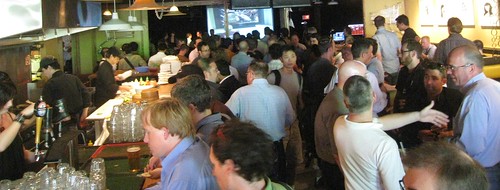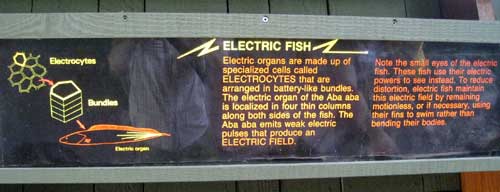

Toronto’s venerable Democamp event kept on ticking last night at the “supermarket†in Toronto (after too long a break since February). Wonderful crowd out last night. But with the long hiatus the it seems the demand for camps is exceeding supply. The event was long sold out and so packed some might have called it barely legal. Before the first demo, we’d already drank the bar out of glassware.
It was refreshing to have DemoCamp back at a more social venue (read hipster drinking establishment). The problem was that supermarket is built like a long flat tube. Sight and sound was a challenge and presenters had a challenge keeping the crowd engaged. Kindof like presenting from the wrong end of a subway tunnel. The good news was several good demoers last night rose to the challenge.
Here are my hasty notes on the demos as they happened:
Refresh partners Roy
Refresh presenting analytics, for facebook aps. Better than google analytics their differentiator is they track influencer scores, viral coefficients that you can blend into your facebook aps which is key for growing your cpm from cents to dollars (that’s the theory anyway). Been running it in house for their brand customers, but are now releasing it? Looks like a handy tool for anyone trying to build viral apps.
Blueprint requirements centre
To do with increasing quality of requirements. It’s based on eclipse its for capturing requirements. Um the app is fine, but why are we watching a sales demo? Quote of the day: What the audience gets out of the demo: increased awareness of blueprint analytics. But Woo! seat licences are 10 grand. The audience appreciates this, also wants a version for free (not likely). It does have commenting and collaboration tools built in. For what it’s worth, looks like it does what it says on the tin: looks like it does a thorough job of capturing requirements for a major software project.
Demo3: labs.well.ca
Ali and his intern (you have to yell at interns) are up and they are hollering into the mic like rockstars so eveyone can hear and they are demoing live chat for ecommerce websites, it has avatars, the usual webchat features and looks pretty good. If you have a simple question to ask a website you might have a quick solution. They looked at free and paid solution and wanted something better. Its comet based so its scalable, its not webbased in the backend it’s jabber. and the live chat can push pages on the site without losing the conversation thread. Slick, a proper demo and the well guys have panache. Works with any jabber client, eg adium. Sign up, try it out at labs.well.ca
Demo 4: A Dr project student demo it seems like?, this one a little harder to follow. IRC Chat interface of sorts for drprojectbot for injecting and receiving ticket info.
Jesse brown Bitsrips
Introducing himself as the creator of the most fun website ever made in Toronto. This may actually be the most fun website ever made in Toronto. Bitstrips lets anyone make cartoons. You can pretty much make anybody. Its sort of a ridicule engine. Jesse is making himself now and it’s pretty cool. As soon as you make a character it exists in a number of expressions and poses. You can make a comic share with friends they can edit it. Its fully social you can embed on your blog and soon facebook. I now want to put bitstips in all my future blog posts.
Spreed
Spreed is an iphone news and it speed reads articles for you with keywords somehow. So you can in theory read 300 to 400 words per minute. An unfortunate fail on the playing of audio with their demo video, but then we didn’t really want to see a canned marketing demo anyway. Combining cognitive science on reading comprehension with software. Nice to see mobile aps and apps with science behind them like this coming out of Toronto. Will have to try it first however to know if it really works.
Lastly: Jevon‘s Ignite rant
Great ignite rant by jevon on the vc industry in Canada. Vc investment has cratered in Canada, plethora of stats, it’s up to vcs and start-ups to save the industry, dream bigger connect to your communities, what’s new now are that communities are holding each other accountable, that there is a flood of new and connected talent in Canada. It’s up to investors to take risks discover this opportunity, it’s up to startups to kick ass and save the VC industry. More always at StartupNorth.ca and StartupIndex.ca.
That’s it. Was great to see everyone again, we’ll have to get more camps going again sooner (mental note). Personal fav demos of the night: well.ca, bitstrips and Jevon’s VC rant.





